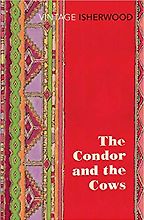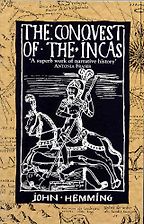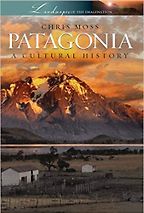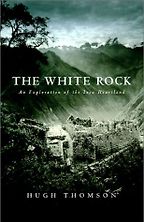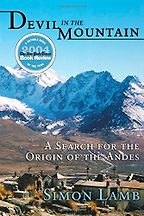Your first book is by Christopher Isherwood, The Condor and the Cows: A South American Travel Diary.
Modern travel books on South America are so scarce and generally cliché-ridden that it is wonderful to find one so fresh, funny and perceptive as Christopher Isherwood’s beautifully written The Condor and the Cows. Isherwood, curiously enough, had no desire to write this book (he was commissioned by his American publishers), and developed a general distaste for the continent, and for the Andes in particular, which he found claustrophobic and gloomy. The book is appropriately sarcastic, curmudgeonly and iconoclastic, in a way that prefigures Paul Theroux’s Patagonian Express. Yet, whereas Theroux has little of interest to say about the Andes (his whole attitude towards the mountains was determined by altitude sickness), Isherwood shows continual curiosity in the politics, culture and history of the countries he goes through. In Ecuador, for instance, he goes out of his way to meet the leading Ecuadorean painter Guaysamin, and finds him a charismatic person who had begun to inspire an indigenous cultural revival. Many of Isherwood’s political judgments are very pertinent today. And he got the Incas absolutely right.
How?
He recognised the greatness of Inca civilisation without in any way idealising it, as do so many other writers. The Incas were as bloodthirsty as the Spaniards, and no less brutally imperialistic; and, as with the similarly romanticised Muslim civilisation in Spain, their downfall was greatly assisted by internal dissent. I think that Isherwood would have been in agreement with many of the views of the Peruvian novelist Mario Vargas Llosa, who attributes to the Incas the gloomier side to his nation’s character, and who is critical of such present-day political correctness as replacing a statue of Pizarro in Lima’s main square with an entirely bogus Inca flag (the Incas, of course, never had a flag). Isherwood himself memorably characterised the Incas in terms of ‘Much ritual, little spirituality. Much gold, little elegance. Much feasting, little fun.’
And now John Hemming’s The Conquest of the Incas.
Though I’m reluctant to promote a book covering such an endlessly written-about subject, this work remains unrivalled as a vivid, readable and detailed account of Andean history. The story of how a small group of Spanish soldiers manage after 1532 to destroy a civilisation is an undeniably fascinating one, and still difficult fully to grasp. The blind Bostonian historian William Hickling Prescott, in his History of the Conquest of Peru, told the same story with considerably panache, but did not have access to all the chronicles and massive archival material that Hemming had. Nor did he have Hemming’s firsthand explorer’s knowledge of South America. Hemming, though a persuasive chronicler of Westerners’ destruction of South America (he has subsequently devoted his attention to the Amazonian rain forest), is also a rigorously objective historian keen to separate fact from fiction, and capable of creating memorable rounded portraits of the conquistadors. He has, as well, a novelist’s eye for detail, such as his description of the way the Spaniards led by Pizarro were literally pissing themselves with fear when they first confronted the Inca emperor Atahualpa (a detail delicately omitted by Prescott).
Your next book is Patagonia by Chris Moss.
Why haven’t I chosen Bruce Chatwin’s In Patagonia, you may ask! Once you read this you’ll know why. While Chatwin’s book is a memorable stylistic achievement, it gives remarkably little idea of what Patagonia is actually like and concentrates on the most hackneyed aspects of the region’s history. He also convinced thousands of readers that Patagonia was a place few people visited or wrote about, a bizarre and mysterious region inhabited by the desperate, the mad and the Welsh.
Chris Moss’s book is a necessary reminder that Patagonia has inspired more and better travel books than almost any other part of South America, and that it is now a heavily commercialised region. One of Signal Books’ excellent ‘Landscapes of the Imagination’ series, the book is even more remarkable for having been entirely rewritten after Moss experienced every author’s greatest nightmare – the stealing of his computer.
Provocative, thought-provoking and brilliantly insightful on authors such as Theroux and Chatwin (‘dated and dusty’), Moss’s Patagonia dwells on every conceivable aspect of the region, from the French philosopher Baudrillard’s stay in Ushuaia to the pioneering aviation exploits of Saint-Exupéry. One of the chapters brilliantly evokes the terrors of night flying in one of the windiest corners of the world.
Why was anyone flying around in the turbulent skies out there?
Flying was a wonderful way of exploring some of the more inaccessible areas of Patagonia (such as the vast ice field known as the Hielo Patagonico); and planes were essential for the bringing of post to such major centres of the wool trade as Punta Arenas, which had a large European community, despite its isolated position ‘at the end of the world’. The very dangers of flying in Patagonia were also a draw to such notorious daredevils as the First World War German spy and adventurer Gunther Pluschow, who had a fatal crash here after his plane’s rudder went out of control.
Your fourth book is Hugh Thomson’s The White Rock: An Exploration of the Inca Heartland.
I try to read every travel book that appears on South America, and most are either lightweight, superficial, gung-ho or pseudo-spiritual, with tales of visits to shamans and mystical experiences in front of Inca stones. Some of the more popular ones, such as Matthew Parris’s witty Inca-Kola: A Traveller’s Tale of Peru, read at times like a Boy’s Own adventure. Hugh Thomson’s The White Rock is a genuinely engaging tale, which indeed is so exciting that Disney Productions apparently bought the film rights.
Written with youthful enthusiasm, it tells how Thomson was working in a London pub when asked to join a team of archaeologists near Macchu Pichu. Thomson, knowledgeable in Spanish but new to South America and to archaeology, wittily relates his deepening investigations into Peru’s ancient past, and his own involvement in the world of exploration, leading to his discovery of an unknown Inca site. Refreshingly down-to-earth in his interpretations of Inca monuments, the book is also full of memorable characterisations of such earlier Andean personalities as Hiram Bingham and the Cuzco photographer Martin Chambi. Truly unforgettable is his account of the controversial American explorer and evangelical preacher Gene Savoy, with whom Thomson rashly teams up. Fortunately, Thomson has the humour to survive his collaboration with this Indiana Jones-like figure. The resulting book is probably the most enjoyable and intelligent travel book to be written on South America in the last 20 years.
Apart from yours.
Apart from mine, of course!
Lastly, Simon Lamb, Devil in the Mountain: A Search for the Origin of the Andes.
Most of the more serious books on the Andes tend to be tedious anthropological and sociological studies, or else barely comprehensible works of ‘geo-history’. Lamb’s book achieves the truly remarkable feat of making geology fascinating for laymen such as myself. As with The White Rock, it endearingly weaves personal experience into the narrative, making the search for the ‘origins of the Andes’ as gripping as any detective fiction. It gives also a very good insight into the frustrations of working in the Bolivian Andes (notably the country’s volatile political situation), and highlights both the beauty and the bleakness of the Andean environment (one of the villagers whom Lamb meets tells him that, whereas Lamb and his colleagues can leave whenever they want to, he and his family have no escape). But, above all, the book lucidly explains the evolution of geology since scientists first asked themselves how mountains were created. The book completely changed my own view of the Andes.
I had simply thought that the 20th-century science of plate tectonics explained all that was necessary about the formation of mountains, and that the Andes were essentially the result of the collision between the Nazca and South American plates. Thanks to Lamb, I began to see the earth’s crust as being fluid rather than solid, and to think of mountains as having a beginning and an end just like human beings. In fact, I was encouraged by him to follow their entire four-and-a-half-thousand-mile length, and to observe them as I would the unfolding of a human life. I started my journey in tropical Venezuela, where the German scientist Humboldt located the life force, and ended in midwinter in the bleak islands off Tierra del Fuego, where Darwin concluded there was no life at all.
January 11, 2010. Updated: September 23, 2019
Five Books aims to keep its book recommendations and interviews up to date. If you are the interviewee and would like to update your choice of books (or even just what you say about them) please email us at [email protected]
Five Books interviews are expensive to produce. If you've enjoyed this interview, please support us by donating a small amount.
